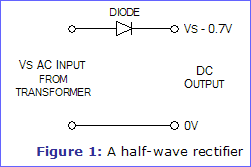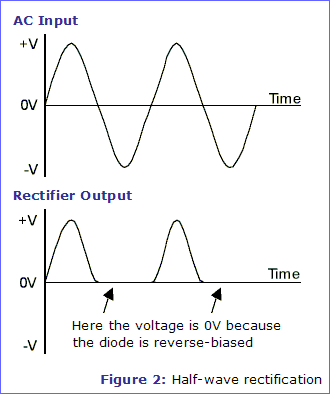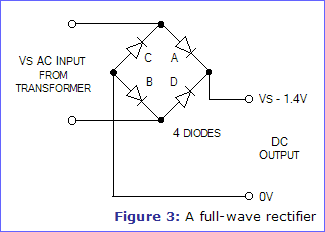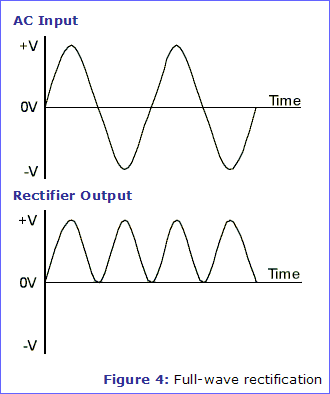|
The Rectifier By Tim Surtell |
| |
||||
| |
Control your Meccano models (or anything else) from your Windows PC!
Take a look at my new MECControl project at meccontrol.com
The purpose of a rectifier is to convert an AC waveform into a DC waveform. There are two different rectification circuits, known as 'half-wave' and 'full-wave' rectifiers. Both use components called diodes to convert AC into DC.
A diode is a device which only allows current to flow through it in one direction. In this direction, the diode is said to be 'forward-biased' and the only effect on the signal is that there will be a voltage loss of around 0.7V. In the opposite direction, the diode is said to be 'reverse-biased' and no current will flow though it.
| Further Information | Diodes |
The Half-wave Rectifier
The half-wave rectifier is the simplest type of rectifier since it only uses one diode, as shown in figure 1.

Figure 2 shows the AC input waveform to this circuit and the resulting output. As you can see, when the AC input is positive, the diode is forward-biased and lets the current through. When the AC input is negative, the diode is reverse-biased and the diode does not let any current through, meaning the output is 0V. Because there is a 0.7V voltage loss across the diode, the peak output voltage will be 0.7V less than Vs.

While the output of the half-wave rectifier is DC (it is all positive), it would not be suitable as a power supply for a circuit. Firstly, the output voltage continually varies between 0V and Vs-0.7V, and secondly, for half the time there is no output at all.
The Full-wave Rectifier
The circuit in figure 3 addresses the second of these problems since at no time is the output voltage 0V. This time four diodes are arranged so that both the positive and negative parts of the AC waveform are converted to DC. The resulting waveform is shown in figure 4.


When the AC input is positive, diodes A and B are forward-biased, while diodes C and D are reverse-biased. When the AC input is negative, the opposite is true - diodes C and D are forward-biased, while diodes A and B are reverse-biased.
One disadvantage of the full-wave rectifier is that there is a voltage loss of 1.4V across the diodes. Why not 2.8V as there are four diodes? Remember that only two of the diodes are passing current at any one time!
While the full-wave rectifier is an improvement on the half-wave rectifier, its output still isn't suitable as a power supply for most circuits since the output voltage still varies between 0V and Vs-1.4V. So, if you put 12V AC in, you will 10.6V DC out.
This is why the 'smoothing' block, described in the next article in this series, is required.
| Related Articles | Building a Power Supply - Part 1 of this series | |||||
| The Transformer - Part 2 of this series | ||||||
| Smoothing - Part 4 of this series | ||||||
| The Regulator - Part 5 of this series |
Building a Rectifier
While is easy to build a full-wave rectifier from individual diodes, you may want to buy a ready-made bridge rectifier like the one shown below. In either case, you need to ensure that the components you choose will work at the voltage and current you require. One of the most popular diodes is the 1N4001 which will work with a voltage up to 50V and pass a current of up to 1A.

 Shopping List
Shopping List
Part
DescriptionQuantity
RequiredRapid
CodeUnit
PriceTotal
Price1N4001 Rectifier Diode 4 47-3130 £0.11 £0.44 KBPC102 Bridge Rectifier 1 47-3206 £0.58 £0.58 Grand Total £1.02
Order the above items from Rapid Electronics via our Circuits Shop and help support the Electronics in Meccano website, without affecting the price you pay! Just click on an item for information about it and/or to add it to your Rapid order.
Orders can also be placed by telephoning Rapid on 01206 751 166 or visiting their website at www.rapidonline.com. Prices quoted include VAT at 20%.
|
|
| Article Information |
Top of Page | Homepage | About | Search | Topics | Features | Circuits Shop | yourEiM |
© 1998 - 2024 Tim Surtell |